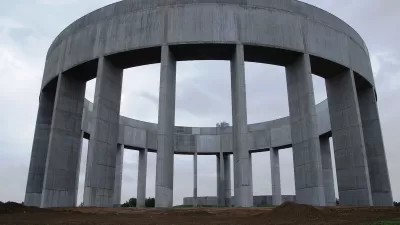What would Richard Neutra do with a third arm? UC Berkeley researchers once asked him that and more, for science.
A recent episode of design podcast 99% Invisible unearthed the records of a 1950s study that aimed to discover the roots of creativity.
The Institute of Personality and Research brought together 40 of the period's most prestigious architects, who, over several weekend retreats in Berkeley, were observed taking tests, performing tasks, and answering all manner of questions (what would be the best place for a third arm? How can architects balance creative vision with clients’ demands?).
Though many types of creative professionals were surveyed, architects were seen as uniquely situated to answer the question of what makes people creative:
Researchers saw architects as people working at a crossroads of creative disciplines, a combination of analytic and artistic creativity. As professionals, architects had to be savvy as engineers and businessmen; as aesthetes, they also acted as designers and artists.
The episode features snippets of conversations among some of the top architects of the period. Plus, the podcast notes, "what IPAR learned helped transform the way people think about creativity today."
Head to 99% Invisible for pictures and artifacts, like the center's original invitation list, signed guestbook, and mosaics by participants (including Richard Neutra) juxtaposed with images of their famous buildings.
FULL STORY: The Mind of An Architect

Planetizen Federal Action Tracker
A weekly monitor of how Trump’s orders and actions are impacting planners and planning in America.

Congressman Proposes Bill to Rename DC Metro “Trump Train”
The Make Autorail Great Again Act would withhold federal funding to the system until the Washington Metropolitan Area Transit Authority (WMATA), rebrands as the Washington Metropolitan Authority for Greater Access (WMAGA).

The Simple Legislative Tool Transforming Vacant Downtowns
In California, Michigan and Georgia, an easy win is bringing dollars — and delight — back to city centers.

The States Losing Rural Delivery Rooms at an Alarming Pace
In some states, as few as 9% of rural hospitals still deliver babies. As a result, rising pre-term births, no adequate pre-term care and "harrowing" close calls are a growing reality.

The Small South Asian Republic Going all in on EVs
Thanks to one simple policy change less than five years ago, 65% of new cars in this Himalayan country are now electric.

DC Backpedals on Bike Lane Protection, Swaps Barriers for Paint
Citing aesthetic concerns, the city is removing the concrete barriers and flexposts that once separated Arizona Avenue cyclists from motor vehicles.
Urban Design for Planners 1: Software Tools
This six-course series explores essential urban design concepts using open source software and equips planners with the tools they need to participate fully in the urban design process.
Planning for Universal Design
Learn the tools for implementing Universal Design in planning regulations.
Smith Gee Studio
City of Charlotte
City of Camden Redevelopment Agency
City of Astoria
Transportation Research & Education Center (TREC) at Portland State University
US High Speed Rail Association
City of Camden Redevelopment Agency
Municipality of Princeton (NJ)





























